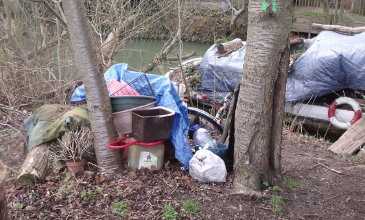David: Bargees? Travellers?
THE chutzpah of the self-styled National Bargees Travellers Association never ceases to amaze me. Its latest semi-literate outpouring really takes the biscuit and I feel that some rebuttal is called for.
 First of all they are not 'bargees' nor are they 'travellers', since their principal aim seems to be to become permanent residents in a single place. Thinking about it, they may be 'travellers' like those people in caravans who break into fields and recreation grounds, stay until they are legally evicted and then go, leaving a filthy mess behind them. Perhaps CaRT should look at using the same legal process to dislodge their waterborne compatriots.
First of all they are not 'bargees' nor are they 'travellers', since their principal aim seems to be to become permanent residents in a single place. Thinking about it, they may be 'travellers' like those people in caravans who break into fields and recreation grounds, stay until they are legally evicted and then go, leaving a filthy mess behind them. Perhaps CaRT should look at using the same legal process to dislodge their waterborne compatriots.
As for the provision of facilities, it is no part of CaRT's job to provide facilities for permanent moorers. The water and sewage points in London are perfectly adequate for transient boaters, for whom they were designed. Yes, there used to be taps at most locks, but these were intended for filling cans quickly while passing through, not for replenishing a tank with a hose pipe.
British Waterways removed these taps in the 70s and 80s when they installed water points in locations where an hour's stop for water did not cause obstruction. As for sewage facilities, these did not exist in working days and it probably ended up in the cut. British Waterways installed Elsan points and later some pump-outs with the development of leisure boating, but again these were intended for the transient boater, not for permanent moorers.
The sort of facilities that these 'bargees' are demanding, which include rubbish disposal and in some cases access to schools are paid for by most people by Council Tax. But these people pay no Council Tax, which is a saving to them of at least £1,500 a year and is one of the reasons why continuous mooring has become so attractive. It would require a change in the law, but it would be perfectly feasible to collect Council Tax from these people via a surcharge on the boat licence, with those of us who do pay providing evidence so as to avoid the charge.
As to moorings, we certainly don't need even more moorings in London for the 'travellers' to clutter up, two or three abreast. More moorings would simply mean more boats, to the point where the London canals would be paved with boats, with only a 14ft (if you were lucky) gap down the middle, with constant abuse for anyone having the temerity to cruise past. What CaRT really needs to do is to make it impossible to moor except at designated sites, where the rules on overstaying would be rigorously enforced, perhaps by a private parking company like the Thames. Mind you, CaRT's policy of tarmacking towpaths for the benefit of cyclists seems to be moving in this direction any way.
The aim of the NBTA seems to be to present themselves as victims, as 'vulnerable people' worthy of our sympathy. They are not; they are simply freeloaders and tax dodgers trying to exploit for their own benefit a system that was never designed for permanent moorers. The sooner CaRT goes to Parliament for fresh legislation to control the problem, rather than trying to rely on old laws which never envisaged an attempt to turn parts of the canal system into a cheap housing estate, the better.
Vegetation (again)
In my last piece I suggested that the towpath cutting which we saw between Napton and Braunston was not addressing the problem of the growth at the water's edge. Having recently cruised past the same length again, I see that I did Fountain's Forestry an injustice.
Now they have finished, all the edge vegetation, including the young trees, has been removed and the whole waterside environment is much better for it. One exception though, is those lengths where there is no steel piling. Here nothing has been done and so there is the occasional thicket gradually extending across the width of the canal. I suspect that this is CaRT policy, but it is a very short sighted one.
David Hymers
